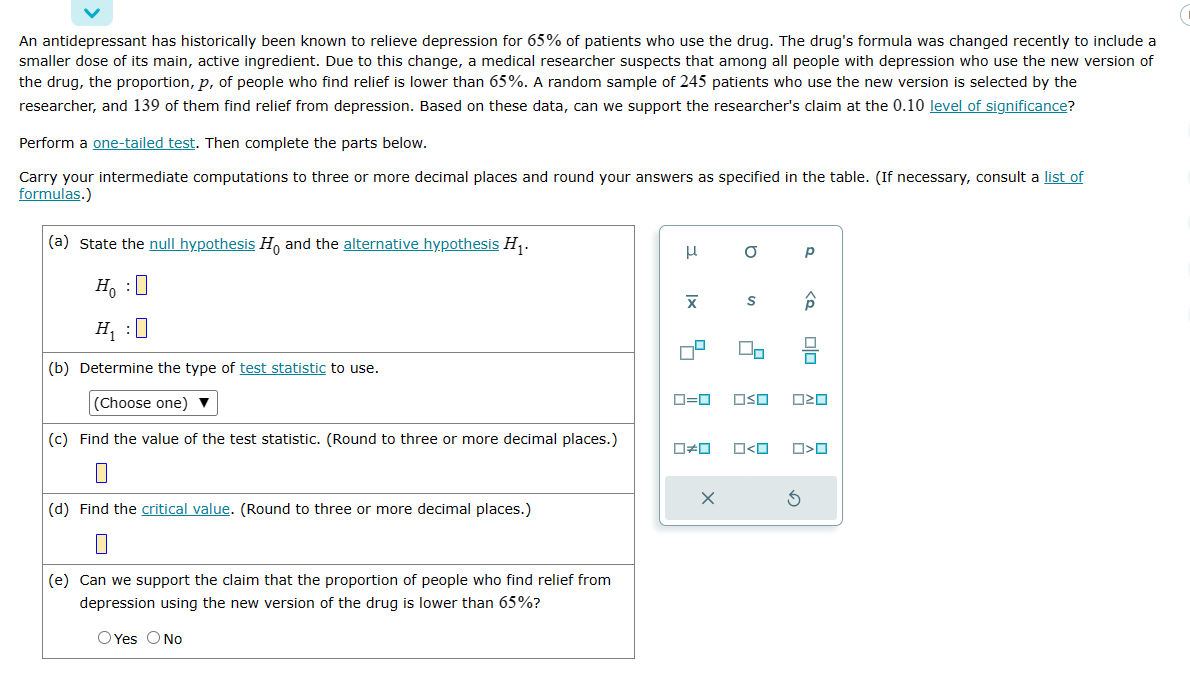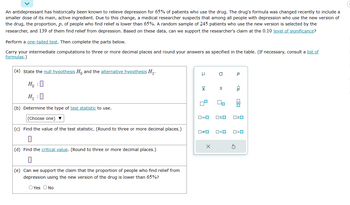An antidepressant has historically been known to relieve depression for 65% of patients who use the drug. The drug's formula was changed recently to include a smaller dose of its main, active ingredient. Due to this change, a medical researcher suspects that among all people with depression who use the new version of the drug, the proportion, p, of people who find relief is lower than 65%. A random sample of 245 patients who use the new version is selected by the researcher, and 139 of them find relief from depression. Based on these data, can we support the researcher's claim at the 0.10 level of significance? Perform a one-tailed test. Then complete the parts below. Carry your intermediate computations to three or more decimal places and round your answers as specified in the table. (If necessary, consult a list of formulas.) (a) State the null hypothesis Ho and the alternative hypothesis H₁. Ho H₁0 (b) Determine the type of test statistic to use. (Choose one) ▼ (c) Find the value of the test statistic. (Round to three or more decimal places.) (d) Find the critical value. (Round to three or more decimal places.) (e) Can we support the claim that the proportion of people who find relief from depression using the new version of the drug is lower than 65%? O Yes O No μ Ix a S 0=0 OSO 0*0 O
An antidepressant has historically been known to relieve depression for 65% of patients who use the drug. The drug's formula was changed recently to include a smaller dose of its main, active ingredient. Due to this change, a medical researcher suspects that among all people with depression who use the new version of the drug, the proportion, p, of people who find relief is lower than 65%. A random sample of 245 patients who use the new version is selected by the researcher, and 139 of them find relief from depression. Based on these data, can we support the researcher's claim at the 0.10 level of significance? Perform a one-tailed test. Then complete the parts below. Carry your intermediate computations to three or more decimal places and round your answers as specified in the table. (If necessary, consult a list of formulas.) (a) State the null hypothesis Ho and the alternative hypothesis H₁. Ho H₁0 (b) Determine the type of test statistic to use. (Choose one) ▼ (c) Find the value of the test statistic. (Round to three or more decimal places.) (d) Find the critical value. (Round to three or more decimal places.) (e) Can we support the claim that the proportion of people who find relief from depression using the new version of the drug is lower than 65%? O Yes O No μ Ix a S 0=0 OSO 0*0 O
Holt Mcdougal Larson Pre-algebra: Student Edition 2012
1st Edition
ISBN:9780547587776
Author:HOLT MCDOUGAL
Publisher:HOLT MCDOUGAL
Chapter11: Data Analysis And Probability
Section: Chapter Questions
Problem 8CR
Related questions
Question

Transcribed Image Text:An antidepressant has historically been known to relieve depression for 65% of patients who use the drug. The drug's formula was changed recently to include a
smaller dose of its main, active ingredient. Due to this change, a medical researcher suspects that among all people with depression who use the new version of
the drug, the proportion, p, of people who find relief is lower than 65%. A random sample of 245 patients who use the new version is selected by the
researcher, and 139 of them find relief from depression. Based on these data, can we support the researcher's claim at the 0.10 level of significance?
Perform a one-tailed test. Then complete the parts below.
Carry your intermediate computations to three or more decimal places and round your answers as specified in the table. (If necessary, consult a list of
formulas.)
(a) State the null hypothesis Ho and the alternative hypothesis H₁.
Ho :O
H₁ :0
(b) Determine the type of test statistic to use.
(Choose one) ▼
(c) Find the value of the test statistic. (Round to three or more decimal places.)
0
(d) Find the critical value. (Round to three or more decimal places.)
0
(e) Can we support the claim that the proportion of people who find relief from
depression using the new version of the drug is lower than 65%?
O Yes O No
μ
Ix
☐#0
X
a
S
OSO
Р
<Q
olo
OZO
O<O O>O
Expert Solution
This question has been solved!
Explore an expertly crafted, step-by-step solution for a thorough understanding of key concepts.
This is a popular solution!
Trending now
This is a popular solution!
Step by step
Solved in 7 steps with 1 images

Follow-up Questions
Read through expert solutions to related follow-up questions below.
Follow-up Question
I submitted the below answers that were provided the first time I asked this question and the system said my answer was incorrect and to try again. I don't know which answer was wrong. The original question is also attached.
(a) The null hypothesis is �0:�≥0.65 and the alternative hypothesis is �1:�<0.65.
(b) The z type of test statistic is to be u. sed.
(c) The value of the test statistic is 2.7139.
(d) The critical value is -1.28155.
(e) Yes, there is sufficient evidence to support the claim that the proportion of people who find relief from depression using the new version of the drug is lower than 65%.

Transcribed Image Text:An antidepressant has historically been known to relieve depression for 65% of patients who use the drug. The drug's formula was changed recently to include a
smaller dose of its main, active ingredient. Due to this change, a medical researcher suspects that among all people with depression who use the new version of
the drug, the proportion, p, of people who find relief is lower than 65%. A random sample of 245 patients who use the new version is selected by the
researcher, and 139 of them find relief from depression. Based on these data, can we support the researcher's claim at the 0.10 level of significance?
Perform a one-tailed test. Then complete the parts below.
Carry your intermediate computations to three or more decimal places and round your answers as specified in the table. (If necessary, consult a list of
formulas.)
(a) State the null hypothesis Ho and the alternative hypothesis H₁.
Ho :O
H₁ :0
(b) Determine the type of test statistic to use.
(Choose one) ▼
(c) Find the value of the test statistic. (Round to three or more decimal places.)
0
(d) Find the critical value. (Round to three or more decimal places.)
0
(e) Can we support the claim that the proportion of people who find relief from
depression using the new version of the drug is lower than 65%?
O Yes O No
μ
Ix
☐#0
X
a
S
OSO
Р
<Q
olo
OZO
O<O O>O
Solution
Recommended textbooks for you

Holt Mcdougal Larson Pre-algebra: Student Edition…
Algebra
ISBN:
9780547587776
Author:
HOLT MCDOUGAL
Publisher:
HOLT MCDOUGAL

Holt Mcdougal Larson Pre-algebra: Student Edition…
Algebra
ISBN:
9780547587776
Author:
HOLT MCDOUGAL
Publisher:
HOLT MCDOUGAL